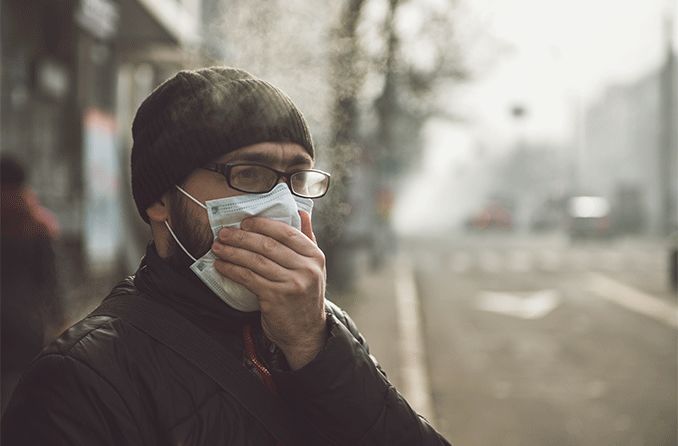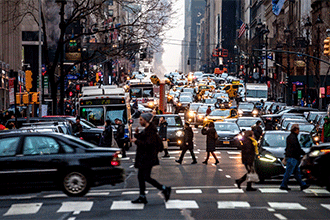How can air pollution affect your eyes?

As populations and industries grow around the world, air pollution does as well. And although some of the most common health problems associated with pollution are respiratory problems, there are many other issues to be aware of too, including some that affect the eyes.
Air pollution can impact any organ in the body. When it does, it can cause serious conditions such as respiratory disease, lung cancer, stroke and heart problems — all of which can become life-threatening.
Several things can affect air quality, from weather changes to wildfire smoke. Ultraviolet radiation exposure and fuel emissions can also factor in — and all can cause irritation and illness in the people exposed.
But air pollution doesn’t just affect the way you breathe; it can also have a negative impact on your eye health. And it can occur in both the short and long term, with varying severities.
How can air pollution affect your eyes?
Air pollution affects many parts of health — especially your eyes.
The structures and tissue located on the surface of your eyes are directly exposed to air pollution. This includes the eyelids, cornea (the clear, protective layer), sclera (the white part of the eye) and the eye's natural lens. Each of these parts is sensitive to harsh irritants found in the environment, both inside and outside. When exposed, you may experience discomfort, inflammation, blurry vision and other symptoms.
It’s important to be aware of these irritants, what may trigger a reaction in your eyes, and how to deal with it in the short and long term.
Types of air pollution that affect eye health
There are numerous aspects of air pollution that can impact your eye health, including air quality, sun exposure and even humidity.
Some of the most common forms of air pollution include:
Air pollution can occur both indoors and outdoors.
Dry air and wind
Dirt
Pollen
Smog
Dust (both indoor and outdoor)
Aerosol sprays, such as hairspray and household cleaners
High-altitude areas, which can have a higher wind index
Humidity and other weather factors
Increased ultraviolet (UV) exposure, caused by ozone depletion
Traffic-related air pollutants such as nitrogen dioxide (NO₂) and carbon monoxide (CO), given off by car exhaust
Charcoal- and wood-burning fires
Crop-clearing fires
Cigarette smoke inside and outside
Soot
Fumes and emissions from power plants, construction sites and industrial processes
Other various airborne pollutants, particles and irritants
Certain areas may produce more irritants than others. For example, air can be saltier near beaches, and there may be more fumes in the air in areas with volcanic activity. Smoke damage to the eyes can occur more often in industrial areas and regions where wildfires are common. Desert-like environments are dryer than other climates, which can cause additional irritation.
Did you know? As the effects of climate change heighten, the effects of air pollution on the body also increase.
READ NEXT: How climate may affect eyes and vision
Effects of air pollution on eyes
Air pollution affects eyes in several ways, both in the short and long term. In some cases, short-term effects can lead to long-term conditions, so it’s important to treat issues immediately and keep your eyes protected from further harm.
Short-term effects
Short-term issues that can result from air pollution include:
Worsened eye allergies and a higher risk of allergic conjunctivitis
Dry eyes — especially for contact lens wearers
These effects can potentially lead to long-term problems if left untreated, so don’t ignore any signs of trouble.
Note: If a dust particle or piece of debris enters your eye, it can be tempting to rub your eyes to try and remove it. Don’t. Your hands carry a great deal of bacteria that spreads easily. Touching your eye with dirty fingers can potentially lead to an unpleasant infection such as conjunctivitis or a stye.
Long-term effects
The following long-term eye conditions may occur following exposure to air pollution:
While some long-term conditions are treatable, others can lead to permanent vision loss.
How do air pollutants cause eye problems?
What is it about air pollution that makes it so hard on the eyes? Here are some more detailed explanations:
Dry environments may cause chronic dry eye
Environmental conditions such as wind, dust and aridness all directly contribute to dry eyes, which can become chronic over time. Living in a dry environment or being exposed to one on a frequent basis not only makes the problem worse, but it can also make your eyes more susceptible to pollution-related irritants.
Tear film can be affected by dry environments, as well as irritating particles in the air like dust and pollen. This may lead to problems such as meibomian gland dysfunction, an inflammation of the small glands in your eyelids that produce your tears. Blepharitis (eyelid inflammation) is also a possibility.
Toxins can restrict blood flow in the eyes
Studies have shown that a high concentration of airborne toxins can interrupt the blood flow in the eyes’ blood vessels. If normal blood flow in the eyes is blocked or restricted, it can lead to eye stroke, retinal vein occlusion, glaucoma and more.
Increased UV exposure can cause cataracts
Ultraviolet exposure is another concern for pollution-related eye problems, including photokeratitis, cortical cataracts, pingueculae and pterygia.
How is ultraviolet exposure related to air pollution? The ozone layer is designed to protect the earth from harmful UV radiation. But air pollution has created a hole in the ozone layer that has grown larger and larger over time. This means the ozone layer can’t fully protect the earth from UV rays, and people are more exposed to sun damage and other UV-related health problems. This is why it is so important to protect the eyes with 100% UV-blocking sunglasses, sunblock and wide-brimmed hats.
SEE RELATED: How can the sun damage your eyes?
Car exhaust may increase the risk for AMD
A population-based study conducted in Taiwan suggested that there is a relationship between age-related macular degeneration (AMD) and two gasses associated with air pollution and vehicle emissions: nitrogen dioxide and carbon monoxide.
A 2021 study in the United Kingdom found that people living in high-pollution regions were 8% more likely to develop AMD than those living in less polluted areas. AMD was associated with greater exposure to PM2.5, fine particulate matter in the air that comes from vehicle exhaust and fuel burning.
Smoke from cooking fires may contribute to trachoma
Increased exposure to pollution can contribute to eye infections and other long-term issues.
Research has shown that increased exposure to charcoal or wood cooking fires can increase scarring from a bacterial infection called trachoma. This can cause long-term problems, as trachoma is the leading infectious cause of blindness internationally.
How to protect your eyes from the effects of air pollution
You can avoid the harmful effects of air pollution on your eyes with the right protection. Here are some ways to do so:

People who live in more polluted areas have an increased risk of eye problems.
If you’re allergic to atmospheric pollutants like smog, dust and tobacco smoke, give your eyes a rest when they get irritated and wear your glasses instead of your contacts.
Wear UV-protective sunglasses and a wide-brimmed hat for protection against UV rays.
Avoid jogging in areas with heavy traffic (there is more vehicle-related pollution there).
Wear protective goggles when doing yardwork or similar outdoor activities.
Avoid rubbing or scratching your eyes if you come into contact with an irritant.
Stay indoors if possible when the air quality is low. You can find the air quality in your area by checking the EPA air quality index.
Keep your car windows closed when driving to avoid eye irritation from wind and debris.
Remember to wash your hands frequently to avoid the spread of bacteria from your hands to your eyes.
Practice good contact lens hygiene.
Finally, stay aware of your surroundings and how the environment may affect your eyes on a day-to-day basis. Studies have shown that people who live in more polluted areas have an increased risk of eye problems. Cities such as New York City, Los Angeles, Chicago and Miami are among many metropolitan areas that have a large percentage of people with dry eye syndrome.
How to repair damage to your eyes from air pollution
If you’ve already experienced eye damage due to air pollution, there are certain steps you can take to improve your condition. Many remedies can be given at home, depending on the severity of the problem. It may help to:
Treat eye inflammation with a cool compress.
Use lubricating eye drops if you experience dry eyes.
Use a humidifier to add moisture to the air and relieve dry eye symptoms.
Consider using an air purifier to reduce indoor air pollution.
Treat serious short-term and long-term conditions caused by air pollution under the direction of your eye doctor.
Work with your eye care provider to find the best plan for your eyes, especially if home treatments don’t help. Your needs could be different depending on the climate that you live in, your medical history and the severity of your symptoms.
Additionally, it’s important to see an eye doctor once a year for a comprehensive eye exam. This can help your doctor identify any changes in your vision, including changes that may have been brought on by the air quality around you.
READ NEXT: Vaping, like smoking, may harm your eyes
Yet another health problem linked to air pollution: Eye disease. Time. August 2019.
Hopkins vision researcher links environmental change to eye health hazards. National Eye Institute. December 2015.
Air pollution is causing permanent damage to eye health. Earth.org. December 2020.
Adhesion of pollen particles to daily disposable soft contact lenses. Clinical Optometry. March 2021.
Impact of air pollution and weather on dry eye. Journal of Clinical Medicine. November 2020.
Residents of most polluted U.S. cities – New York City, Chicago, Los Angeles and Miami – have increased risk of dry eye syndrome. American Academy of Ophthalmology. November 2013.
Traffic-related air pollutants increase the risk for age-related macular degeneration. Journal of Investigative Medicine. August 2019.
Particle pollution. Centers for Disease Control and Prevention. September 2019.
The relationship between ambient atmospheric fine particulate matter (PM2.5) and glaucoma in a large community cohort. Investigative Ophthalmology & Visual Science. November 2019.
Chalazion and stye risk factors. Stanford Health Care. Accessed April 2022.
How air pollution affects the eyes — a review. Ophthalmology Journal. November 2018.
Air pollution linked to higher glaucoma risk. ScienceDaily. November 2019.
Eye stroke - symptoms and causes. Penn Medicine. Accessed April 2022.
Retinal vein occlusion. MedlinePlus. February 2020.
Glaucoma progression is associated with decreased blood flow velocities in the short posterior ciliary artery. British Journal of Ophthalmology. October 2006.
Effects of air pollution. UCAR Center for Science Education. Accessed April 2022.
Impact on eye health regarding gaseous and particulate pollutants. Aerosol and Air Quality Research. May 2020.
AirNow. AirNow.gov. Accessed April 2022.
Ocular blood flow and cerebrospinal fluid pressure in glaucoma. SAGE Journals. February 2016.
Association of ambient air pollution with age-related macular degeneration and retinal thickness in UK Biobank. British Journal of Ophthalmology. April 2022.
Air pollution can cause eye problems, study shows. American Academy of Ophthalmology. November 2021.
Fine particles (PM 2.5) questions and answers. New York State Department of Health. February 2018.
Page published on Thursday, May 12, 2022
Medically reviewed on Friday, April 15, 2022






